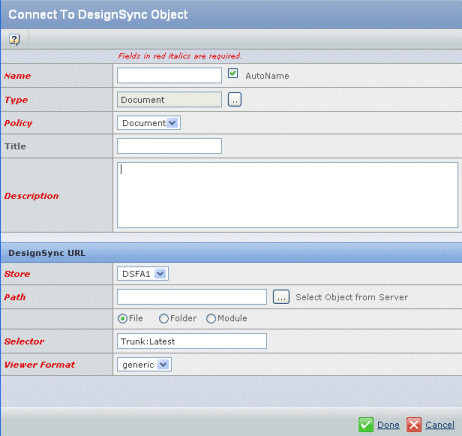In the File Summary page, select Checkin DesignSync Object or Connect to DesignSync Object from the Actions menu.

Enter the following details:
| Field Name |
Description |
|---|
| Server |
Select the DesignSync server. |
| Path |
Use the browse button to select the path, or type the path into the text box. If you manually enter the path, it cannot contain any of these special characters: @,*?[]#${}"<>|: ' ~%^&()`= If you manually enter the path and select a folder, the path field must not end with ';' since a folder cannot end with a semicolon. For a module, the local path for a module must be /Modules. The path name should resolve to a module or module version on the DesignSync server. If the path needs to create a module, the new module cannot be created under another module. |
| Selector |
Enter the name of the branch where the file will be stored. If the branch entered is not a legal branch selector, an error is returned during check in.
- If you enter Trunk, the systems appends :Latestto the branch; the selector would be Trunk:Latest.
- If you enter a text string with a colon, the system appends Latest to the branch. For example, if you enter Gold:, the selector would be Gold:Latest.
- If you enter a text string other than Trunk without a colon, the system does not append anything to the branch. For example, if you enter Gold, the selector would be Gold.
|
| Viewer Format |
Select the format (for example JT) in which you want the file to open for viewing. |
To search for the path:
-
Click
 for Select Object from Server (see Creating a New or Connecting to an Existing DesignSync Object for details of this screen). for Select Object from Server (see Creating a New or Connecting to an Existing DesignSync Object for details of this screen).
When checking in a DesignSync file or folder, the Select page lists only DesignSync folders. Only branches and versions of files show a value in the Version or Tags columns; the top-level file is not a specific version and does not show versions or tags.
-
Select the module, file or folder where you want to check in.
-
Click Submit.
Your choice sets the button for the selected type of DesignSync object: File, Folder, or Module.
If creating a new object, see Checking In a DesignSync File or Folder to upload the needed file or folder.
If connecting to an existing DesignSync object, click Done.
The connection is created. A business object is created and all metadata related to the connection are stored in this object for reference.
The connect operation succeeds even if no physical file exists in DesignSync.
If you see an error message with "connection refused", then the DesignSync server is down or otherwise unavailable. Contact your System Administrator for help.
|